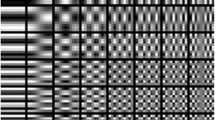Abstract
Block-based transform coding is the most popular approach for image and video compression. The objective measurement of blocking artifacts plays an important role in the design, optimization, and assessment of image and video coding systems. This paper presents a new algorithm for measuring blocking artifacts in images and videos. Instead of using the traditional pixel discontinuity along the block boundary, we use the edge directional information of the images. The new algorithm does not need the exact location of the block boundary thus is invariant to the displacement, rotation and scaling of the images. Experiments on various still images and videos show that the new blockiness measure is very efficient in terms of computational complexity and memory usage, and can produce blocking artifacts measurement consistent with subjective rating.
Similar content being viewed by others
References
Bazen A.M., Gerez S.H. (2002). Systematic methods for the computation of the directional fields and singular points of fingerprints. IEEE Transactions on Pattern Analysis and Machine Intelligence, 24: (7) 905–919
Gonzalez R.C., Woods R.E. (2002). Digital image processing. Englewood Cliffs, NJ: Prentice Hall
Karunasekera S.A., Kingsbury N.G. (1995) A distortion measure for blocking artifacts in images based on human visual sensitivity. IEEE Transactions on Image Processing, 4(6): 713–724
Kass M., Witkin A. (1987). Analyzing oriented patterns. Computer Vision, Graphics, and Image Processing, 37: 362–385
Miyahara M., Kotani K., Algazi V.R. (1998). Objective picture quality scale (PQS) for image coding. IEEE Transactions on Communications, 46(9): 1215–1225
Sheikh, H. R., Wang, Z., Cormack, L., Bovik, A. C. (2002). LIVE image quality assessment database, http://live.ece.utexas.edu/research/quality.
Shi Y.Q., Sun H. (1999). Image and video compression for multimedia engineering – fundamentals, algorithms and standards. CRC Press, Boca Raton
VQEG (2000). Final report from the video quality experts group on the validation of objective models of video quality assessment, http://www.vqeg.org/.
Wang, Z., Sheikh, H. R., Bovik, A. C. (2002). No-reference perceptual quality assessment of JPEG compressed images. 2000 IEEE International Conference on Image Processing, Rochester, New York, September 22–25, I-477–480.
Wu H.R., Yuen M. (1997) A generalized block-edge impairment metric for video coding. IEEE Signal Processing Letters, 4 (11): 317–320
Yu Z., Wu H.R., Winkler S., Chen T. (2002). Vision-model-based impairment metric to evaluate blocking artifacts in digital video. Proceedings of the IEEE, 90(1): 154–169
Author information
Authors and Affiliations
Corresponding author
Rights and permissions
About this article
Cite this article
Pan, F., Lin, X., Rahardja, S. et al. Using edge direction information for measuring blocking artifacts of images. Multidim Syst Sign Process 18, 297–308 (2007). https://doi.org/10.1007/s11045-006-0008-6
Received:
Revised:
Accepted:
Published:
Issue Date:
DOI: https://doi.org/10.1007/s11045-006-0008-6




